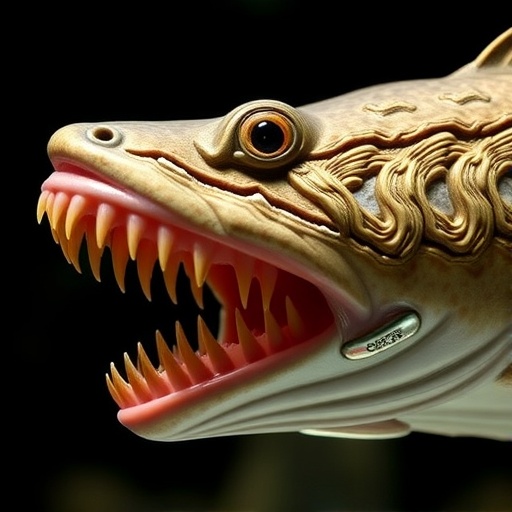In the sprawling timeline of life’s evolution on Earth, few chapters capture the imagination quite like the earliest development of vertebrate jaws. These seemingly simple structures not only revolutionized feeding strategies but also set the stage for the rise of complex vertebrate ecosystems, ultimately paving the way for the vast diversity of animals we see today. Recent research from the University of Michigan published in Current Biology has shed new light on the jaw evolution of ancient bony fishes, revealing surprising role reversals in their macroevolutionary trajectories. This study unveils that a group of fishes once thought to have modest evolutionary rates exhibited a burst of diversification and innovation hundreds of millions of years ago, challenging long-held assumptions about fish evolution.
Lobe-finned fishes, a lineage that today counts only eight extant species including lungfish and coelacanths, underwent an explosive diversification of jaw morphologies and functions during the Devonian period—approximately 359 to 423 million years ago. This period, often dubbed the “Age of Fishes,” was pivotal in vertebrate history, marked by dynamic evolutionary experimentation. The research team employed high-resolution 3D models derived from CT scans of fossil specimens, meticulously reconstructing the jaw mechanics of 86 fish species spanning Silurian to Devonian periods. Their comprehensive analysis disclosed that lobe-finned fishes evolved jaw structures with markedly higher rates of change and functional innovation than their contemporaries, the ray-finned fishes.
Ray-finned fishes, today encompassing over 33,000 species and representing the most speciose vertebrate group, exhibited considerably slower evolutionary rates in jaw development during this era. This discovery is paradoxical given the vastly greater diversity and ecological dominance of ray-finned fishes in the present day. The coelacanth, a notable lobe-finned fish, famously rediscovered in 1938 after being considered extinct, underscores the group’s enigmatic legacy. Although modern lobe-finned fishes appear evolutionarily stagnant with limited jaw variation, the fossil record reveals an ancient past marked by rapid morphological experimentation and adaptation.
The lead author of the study, postdoctoral researcher Emily Troyer, emphasized the transformative insights afforded by integrating fossil data with cutting-edge imaging techniques. “Without the fossil record, we would have no idea of this inverted role reversal,” Troyer noted. The ability to peer back hundreds of millions of years enabled the researchers to challenge preconceived notions concerning evolutionary dynamics of early vertebrates. It also highlights the critical importance of paleontological data in understanding how major evolutionary innovations unfold through deep time.
Central to their investigation was the concept of mechanical advantage in jaw function—a biomechanical metric describing how effectively a jaw converts muscle force into bite force. By mapping mechanical advantage across species, the team could infer the functional consequences of observed morphological changes. Lobe-finned fishes developed robust, heavily muscled jaws during the early Devonian, an adaptation likely correlated with feeding on hard-shelled prey such as early clams and crustaceans. This suggests that ecological pressures related to diet played a crucial role in driving jaw diversification.
Digital reconstructions allowed detailed quantification of jaw shape, size, and leverage, revealing an adaptive radiation characterized by rapid morphological shifts. Adaptive radiation describes a process where a lineage diversifies rapidly into a range of different forms in response to ecological opportunities or innovations. The lungfish and coelacanth lineages, therefore, represent an ancient instance of this evolutionary principle, manifesting through novel feeding strategies embodied in jaw morphology and mechanics. These evolutionary adaptations were tightly linked with Devonian ecosystems, which presented new niches and resources.
Co-first author Rafael Rivero-Vega contributed significantly to the study by compiling CT scan data for nearly every complete fossil jaw of lobe-finned fishes available in museum collections. His work involved intricate 3D modeling and mapping of jaw characteristics to test hypotheses surrounding evolutionary tempo and mode. Rivero-Vega highlighted how each fish group encountered unique evolutionary pressures, resulting in distinct patterns of jaw diversification and stasis. Some evolved rapidly before stabilizing upon reaching functional ecological niches, while others displayed more gradual morphological changes aligned with terrestrial transitions.
This research frames evolutionary innovation as a variable and context-dependent process, with different vertebrate lineages exploring morphological and functional possibilities at their own pace. The Devonian jaw innovations in lobe-finned fishes predate the rise of tetrapods and the well-known dinosaur clades by hundreds of millions of years, demonstrating how foundational these early adaptations were to vertebrate evolution. Additionally, the study provides a nuanced understanding of how the interplay between form, function, and environment shapes evolutionary pathways.
The implications extend beyond paleontology, informing developmental biology and ecology by illustrating how morphological traits can be influenced by both biomechanical constraints and ecological opportunity. The use of advanced imaging technologies like CT scanning and 3D biomechanical modeling serves as a blueprint for future evolutionary investigations, enabling scientists to derive functional insights from fossilized remains that were previously unattainable. These methodological innovations breathe new life into the study of ancient life, bridging gaps between form and function across geologic epochs.
In sum, the discovery of a shifted evolutionary tempo between lobe-finned and ray-finned fishes during the Devonian challenges conventional narratives about vertebrate history. Rather than a straightforward trajectory toward the modern dominance of ray-finned fishes, the fossil record reveals a complex story of innovation, experimentation, and adaptation. This study not only underscores the richness of this evolutionary tapestry but also invites a reconsideration of how evolutionary potential is expressed unevenly across diverse lineages and time periods.
Subject of Research: Animals
Article Title: Macroevolutionary role reversals in the earliest radiation of bony fishes
News Publication Date: 1-Sep-2025
Web References: http://dx.doi.org/10.1016/j.cub.2025.08.008
Image Credits: E.M. Troyer/University of Michigan
Keywords: Life sciences, Developmental biology, Ecology, Evolutionary biology




